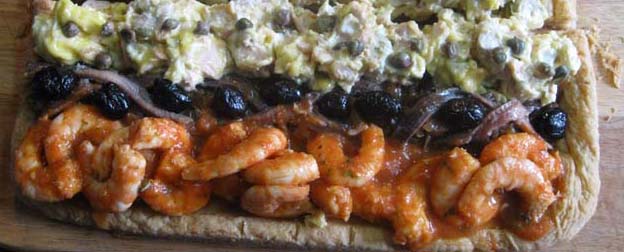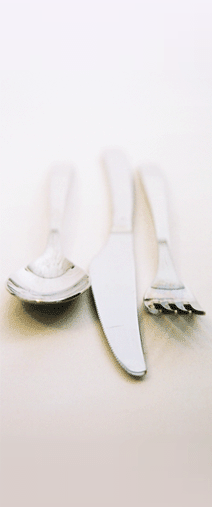
Wondering what starter I was going to put together for a dinner on the terrace of nine people , conscious that I wanted it to be something that could be served easily , Tranche St Remy , a standard from Wife of Bath in Kent where we both worked in the seventies , came to mind.
I had a very strong feeling that it came from an original recipe by Elizabeth David, Michael Waterfield the proprietor was as big a fan of hers as I was/am. (We actually fed her there once , on her way to a channel ferry, but that’s another story).
I scoured her French Cookbook indices , French Provincial Cooking , French Country Cooking and Mediterranean Food but without a sign at all of Le Tranche St. Remy.
We decided we would try and construct it from memory.
It was a large rectangular tart with three different fillings along its length , the base we remembered was puff pastry , one of the fillings was prawns in a tomato sauce , and one tuna (canned in ´70s England ) with green olives and the third , as served in The Wife of Bath was Mushrooms , quickly fried in butter and mixed with Chicken liver pate.
We both agreed that we could easily skip this last one which sounded too rich for the other fillings so I agreed to try it out just with the other two.
Convinced that I had found the recipe somewhere in Elizabeth David I took her to bed with me before I settled on the final version.
(The internet had proved singularly useless , nothing at all came up under Tranche St Remy)
But all was not lost .
In French Provincial Cooking ,under Hot Hors- d’Œuvres, and called Tartlettes Á La Provençale at last I found it.
Coming indeed from “the dusty sleepy town of St. Remy “ wrote Mrs. David in 1960 (St. Remy is now a trendy lively tourist trap )
“It consists of little open pastry cases with three different varieties of fillings : an onion and black olive mixture as described above (a recipe for Pissaladiére ), one of mushrooms and tomatoes and a third with prawns and green olives .”
So we clearly had another scenario on our hands.
All in all I think I preferred Michael Waterfield’s version of the dish but I now had a third filling from Mrs. David, the onion , and olive one , in through which I would certainly introduce some anchovies.
Having just a few weeks ago made myself a Salade Niçoise with fresh tuna instead of tinned , and very much enjoyed the result , I was determined to include this in the Tranche and decided to add a bit of zing to this mixture by adding green olives and capers.
For the base I decided to use my new found skill in making Rough Puff Pastry , a recipe I had pinched from Michel Roux on the internet but simplified by doing the rubbing in the food processor.
The end result was, I thought better than any commercial pastry I might buy.
La Tranche St Remy
(This will give you enough for 12 as a generous starter , I don’t think I would go through all the palaver for less)
You will need a baking tray which will take a piece of pastry 25cm by 35cm.
(an old Swiss roll tin will do fine)
Pastry :
300 g Strong Flour
300g Cold Butter diced into little cubes
Good Pinch Salt
120ml Ice cold water.
Filling One :
500g Prawns cooked and peeled
2 Med Onions
500g Ripe Tomatoes
Handful Basil
Teaspoon sugar
Teaspoon Vinegar
Salt and pepper.
Filling Two
500g Fresh Tuna
14 Green Olives (stoned)
1 Tablespoon Capers
175 g Mayonnaise (make your own if possible )
Filling Three
400g Peeled Sliced Onions
Olive oil
12 Anchovy Fillets
12 Stoned Black olives,
First make the pastry :
Put the flour and the butter in the processor and process.
Check every few seconds , the pieces of butter should still be about the size of small peas.
Now add the water and whizz briefly to amalgamate.
Tip this mixture out on a floured board and pull together to bind. Do not knead or work.
Tip this into a plastic bag and chill for a half hour in the fridge..
Take out and roll into a piece roughly 25cm by 12 cm.
Fold this into three and give it a quarter turn, .roll again into a 25 by 12 rectangle and then fold in three again and chill in a bag in the fridge for 30 minutes.
Repeat this process after 30 minutes and then leave for another 30 mts before using.
For the Tranche , roll this out to a piece 25 cm by 35 cm and bake blind (cover and weigh ) at 175 C , 350F , Gas 4 for about 20 to 30 mts until brown and crisp.
Leave this cool on a rack.
Filling One
Cook the Onion in a little olive oil in a covered pan until soft .
Add the tomatoes, sliced , and continue cooking until these melt.
Liquidise these (or push through a sieve) and season with salt, pepper, sugar and vinegar and the chopped Basil.
Put this into a pot with the prawns, bring to a simmer, take off the heat and cool in the fridge.
Filling Two
Take the tuna off the bone and skin.
Cut into little dice .
Heat some oil in a hot pan and sear the piece quickly on all sides.
Cool in the fridge.
Mix these with the halved olives (I used some stoned Spanish ones which are stuffed with anchovies) the capers and the mayonnaise.
Filling Three
Cook the sliced onions in some oil in a lidded pan on a gentle heat until very soft.
Now take off the lid and increase the heat until they go brown, do not let them burn.
Season these with salt and pepper and chill.
To assemble (about an hour before service.)
Cut the cooked pastry piece into two long strips.
Down the middle of each strip put a line of the onion.
Cross the anchovies down this line and put black olives in the spaces.
Spoon the prawn mixture on one side and the tuna mixture on the other.
Serve in slices like a custard slice . A lotta work but very much worth while.
